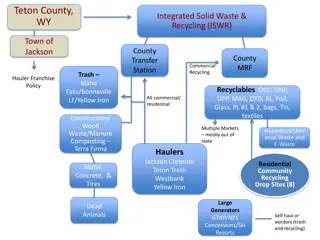Enhancing E-Waste Recycling Through Public-Private Partnerships
Public-Private Partnerships (PPPs) offer a promising approach for e-waste recycling, addressing challenges such as cost sustainability and knowledge gaps. This model leverages the strengths of both the public and private sectors, improving operational efficiency, access to new markets, and the integration of informal workers. Specific PPP strategies include decentralized and centralized approaches, tailored to optimize material recovery and technological solutions. Case studies, like the one in Saharanpur, India, highlight successful waste management practices through community engagement and strategic partnerships.
Download Presentation

Please find below an Image/Link to download the presentation.
The content on the website is provided AS IS for your information and personal use only. It may not be sold, licensed, or shared on other websites without obtaining consent from the author.If you encounter any issues during the download, it is possible that the publisher has removed the file from their server.
You are allowed to download the files provided on this website for personal or commercial use, subject to the condition that they are used lawfully. All files are the property of their respective owners.
The content on the website is provided AS IS for your information and personal use only. It may not be sold, licensed, or shared on other websites without obtaining consent from the author.
E N D
Presentation Transcript
Recycling Infrastructures and Private Public Partnerships Daniel Ternald UNEP IETC November 27th2019
Public Sector + Implements waste management policies + Ensures coordination amongst stakeholders - May not sustain costs of investment and maintenance - May lacks knowledge and key competencies Private Sector + Access to new market + Improves operating efficiency + Provides technical and management skills - Dependent on policies issued by the government Why should PPPs be envisaged for e-waste recycling? PPPs are contractual arrangements between the public sector and a private sector party for the private delivery of public infrastructure services or other basic services Table 1. Data retrieved from ADB
Specificities of e-waste PPPs Decentralized + Greater integration of informal workers + Lower operational expenditure Centralized + Economies of scale + Greater extraction of value through technological solutions Average Composition of Materials found in E-waste 1. Composition of waste -> hazardous, difficult to recycle Metals Plastics Metal-plastic mixture Cables 2. Internationalbuyers market Screens (CRT and LCD) Printed Circuit Boards Other Pollutants 3. High-cost technologies
Business and Administration Use Buyers Primary Waste Segregation and Collection (decentralized) Secondary Waste Segregation and Recycling/Disposal (centralized) Official Takeback system (see case study 1) E-products producers / sellers Private partner to Collect and Segregate waste. This stage should involve local communities (see case study 2) Private partner to Recover/Recycle/ Dispose (see case study 3) Private Use Final Disposal E-waste Exports 1st and 2nd step can be conducted by one or more partners
Case study Municipal Solid Waste in Saharanpur, India Door-to-door collection and primary segregation Secondary segregation at the WM site employing 100 rag pickers 90% recovery of waste Numer of household covered with SWM services 20000 18000 18780 16000 17170 14000 12000 13817 10000 8000 74538159 8170 6000 5488 4000 4137 2000 2254 0 2007-08 2008-09 2009-10 2010-11 2011-12 2012-13 2013-14 2014-15 2015-16 Primary segregation at Saharanpur
Different Segments of Revenue Need for financial incentives: - Tipping fee: charged for unloading waste at a treatment facility for treatment 17.16% - Concession agreements ~50% of revenue from user charges - Low-cost debts and Taxation incentives 48.48% - Viability Gap Funding: supports a percentage of a PPP-based project s capital expenditure. Can be disbursed based on actual performance. 36.36% User Charges Recyclable Waste Sale Compost Sale
E-waste PPP in Hong Kong - Started 2018 - 10 Year contract between ALBA and Gov t of Hong Kong - Re-use, refurbish, disassemble, material recycling - Contract worth 318 million Euros - Capacity estimated at 60,000 tonnes/year
E-waste voluntary partnership Singapore - Started 2015, now 17 partnerships - ReCYCLE by SingPost and SingTel - small IT collection boxes, and free mail- in service - RENEW - 400 E-waste bins across the country - Downside: Mainly targets small electronics
Conclusion PPP projects can be a solution for developing recycling infrastructure in e-waste, however it needs to be designed carefully in regards to: - Legislations and Regulations - Financial and Organizational Risks - Local Community Involvement - Financial Incentives
References - ADB, 2018, Creating an enabling environment for public-private partnerships in waste-to-energy projects, ADB Sustainable Development Working Paper Series (58) - ADB, 2010, Municipal Solid Waste Treatment: Case Study of Public-Private Partnerships (PPP) in Wenzhou - ASSOCHAM Council on Climate Change & Environment, 2018 - Athena Infonomics India Pvt. Ltd., Public Private Partnerships in Municipal Solid Waste Management - HP Planet Partners, available on: https://www8.hp.com/us/en/hp- information/environment/product-recycling.html - International Finance Corporation, 2014, Waste PPPs, Handshake issue #12 - Jackson, C., 2019, Samoa Launches Public-Private Partnership on E-Waste, available on: https://sdg.iisd.org/news/samoa-launches-public-private-partnership-on-e-waste/ - Mohan, G., 2016, Managing of Solid Waste through Public Private Partnership Model, Procedia Environmental Sciences, 35 - StEP, 2009, White Paper: E-waste Take-Back System Design and Policy Approaches
Thank you Daniel Ternald UNEP IETC























